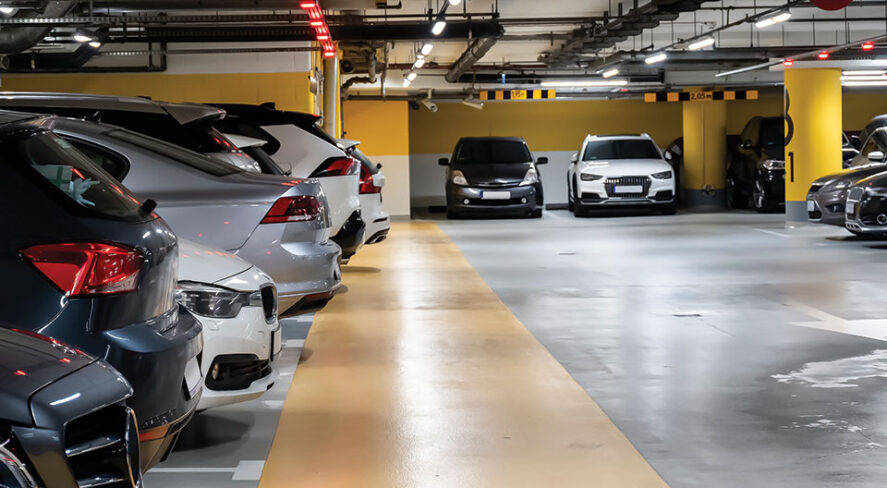How AI Solutions Make Parking Lots Smarter – and More Secure

Artificial intelligence solutions promote a better, safer customer experience

Parking lots and garages are the third most crime-prone areas in the country, according to the U.S. Department of Justice.
More than one out of every 10 property crimes occurs in these areas, totaling about 1,400 incidents every day.
Property owners, city officials and campus administrators have a responsibility to keep people and cars safe.
A parking area that gains a reputation as a place where violent crime occurs or where parked cars are regularly burgled or damaged will quickly become a place that people avoid.
Parking Lot Security Challenges
Parking facilities in city centers and on college campuses are vital to attracting customers and students. These facilities offer a necessary service; however, they often have limited security with poor lighting and are ill-designed with many blind spots.
In addition, many parking lots have poorly maintained shrubbery that can provide cover for potential criminal activity. The major challenge for parking lots, especially large ones, is keeping cars and people visible. Criminals who target parking facilities are usually opportunists looking for an easy target – one that is away from witnesses and security guards – so they go to parking lots that lack security measures.
Security systems in campus and city parking lots provide a variety of benefits. First, they help protect vehicles, deter theft and offer a sense of safety and security for customers. The systems can also be used to monitor and control access to the lots.
Solutions range from simple cameras to more sophisticated deployments, including motion detectors, access control, and the latest analytics using artificial intelligence (AI). A few of the more popular options are examined below.
Traditional Surveillance Cameras
Surveillance cameras are the most common type of security system used in campus and city parking lots. These cameras provide a visual deterrent to potential criminals, enable monitoring of parking lot activity and provide evidence for law enforcement if a crime is committed.
One difficulty with cameras in parking facilities is the sheer size of the area that must be monitored. Parking garages often have multiple levels, and stadium-sized parking areas are vast; covering the entire area would take numerous cameras, driving up costs. A solution to this is to use wide-angle and fisheye lens cameras to monitor large areas with the fewest number of devices, which also saves money on cabling and licenses.
Smart IP Cameras
Smart IP video surveillance cameras offer a decided advantage over traditional cameras, which provide only basic analytics. Today’s smart IP cameras with onboard AI deliver advanced analytic algorithms at the edge, decreasing reaction time and improving security. A few examples of AI functions include:
- License plate recognition (LPR): This analytic detects and reads license plates, which can allow entry to a parking lot and enable operators to track the time a vehicle remained in the facility.
- Vehicle/people counting: This analytic counts the number of vehicles and people entering and exiting a parking facility. It can analyze the capacity of a facility and provide statistics to traffic flow management systems.
- Vehicle identification: This analytic detects and records the type of vehicle (bicycle, motorcycle, car, bus, etc.) and its description. Such information is useful for identifying vehicles that are in violation of parking lot regulations and assisting law enforcement officials investigating vandalism or theft.
Access Control Systems
An access control system allows only authorized personnel to enter the lot. This gatekeeping reduces the risk of crime and can be used to prevent cars from outnumbering available spaces. Many access control systems easily integrate with traditional or smart IP surveillance cameras, offering single-pane-of-glass functionality for control centers or guard stations.
Access control systems, however, can be costly to install and typically require badges or credentials, which, all too often, are lost or stolen.
Lighting
Proper lighting deters criminals by making it more difficult for them to hide or operate in darkness, thus providing a safer environment for drivers and pedestrians. Additionally, lighting can improve security by making it easier for law enforcement officers to identify suspects or witnesses who are captured on video when a crime is committed.
Alarm Systems
Alarm systems alert authorities when an unauthorized person attempts to enter the lot. They can also use motion sensors that detect any suspicious activity within a given area. As with access control systems, alarm systems easily integrate with surveillance cameras to offer a complete record of incidents.
Artificial Intelligence Opens the Door to Improved Security
State-of-the-art video cameras are equipped with the latest in AI software. Today’s AI-driven cameras can analyze enormous amounts of data, make decisions about threat levels, and respond to things that, in the past, would have required human intelligence. Recently, smart IP cameras with onboard AI have hit the market, and they offer a distinct advantage over traditional cameras that require a dedicated server to perform AI functions. AI edge devices reduce latency – the time it takes for data transfer – which enables quicker responses.
Perimeter defense cameras using AI analytics can create a virtual fence line around a parking lot. These cameras can recognize the difference between a false alarm, such as a stray cat, and a real threat, such as a human prowling in an area where they should not be.
The latest cameras can also detect objects left behind, track traffic levels, spot cars that have been in the lot for an extended period of time, and use facial recognition technology to identify people who have been flagged as potential threats.
Where appropriate, a camera can automatically initiate responses, such as turning on a spotlight, playing a loud recording telling a person that he or she is trespassing and authorities are being notified, and alerting a guard at a security hub.
AI-enabled cameras also offer video categorization features that enable easy and quick searches for specific footage.
Enhancing Satisfaction
In addition to security, AI can provide automated customer service in parking lots. AI-enabled chatbots can answer customer questions about parking availability and fees, point customers to available spaces and even offer directions to nearby businesses or attractions. One useful solution combines vehicle detection and counting algorithms with LED signage for parking guidance. This powerful system alerts drivers to the number of available parking spaces in a given area.
All of this makes it easier for customers to find what they need quickly and easily while reducing the need for onsite staff. As AI continues to develop, it will become increasingly important for businesses, city planners, and campus administrators to use this cutting-edge technology to enhance their security measures.
